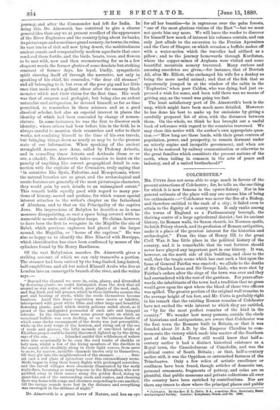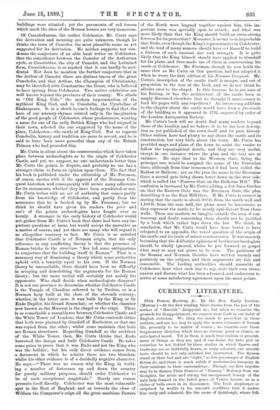C OLC HE STER.*
Mn. CUTTS does not seem able to urge much in favour of the present attractions of Colchester ; for, he tells us, the one thing for which it is now famous is the oyster-fishery. Nor in his general estimate of the place will any one accuse him of being too enthusiastic :—" Colchester was never the See of a Bishop, and therefore entitled to the rank of a city; it failed even to attain to the dignity of a county town. It only ranks among the towns of England as a Parliamentary borough, the thriving centre of a large agricultural district ; but its ancient history, its Roman walls, its Saxon church, its Norman castle, its brick Priory church, and its profusion of Roman antiquities, make it a place of the greatest interest for the historian and archmologist." From the time of Henry III. to the great Civil War, it has little place in the political history of the country, and it is remarkable that its vast fortress should never have played any important part in our history. It was, however, on the north side of this building, and close to the wall, that the tragic scene which has cast such a blot upon the fame of General Fairfax was enacted ; we allude to the deaths of Sir Charles Lucas and Sir George Lisle, who were shot by Fairfax's orders after the siege of the town was over and they had surrendered with the rest of the garrison. For years after- wards, the inhabitants of the town had a tradition that no grass would grow upon the spot where the blood of those two officers was spilled. The greater portion of the original wall remains, to the average height of ten feet, and Mr. Cutts is probably right in his remark that the existing Roman remains of Colchester have not excited the wide interest to which they are entitled, as "by far the most perfect remains of the kind in the country." We wonder how many persons, outside the circle of historians and antiquarians, are aware that Colchester was the first town the Romans built in Britain, or that it was founded about 50 A.D. by the Emperor Claudius to com- memorate the victory which made him master of the Southern part of the island. Fewer still would know that half-a- century earlier it had a distinct historical existence as a, Royal town, the Camulodunum of Cunobelin, and was the political centre of South Britain ; or that, half-a-century earlier still, it was the Oppidum or entrenched fastness of the Trinobantes. Only a few relics of artistic excellence or costliness have been found, though articles of domestic use, personal ornaments, fragments of pottery, and coins are so plentiful, that public museums and private collections all over the country have been enriched by contributions. Nor are there any traces to show where the principal places and public • Colchester. B7 the Rev. E. L. Ontts, B A., sometime Hon. Seoretary,Hteoz Archaeological Society. London : Longmont, Green, and Co. 1888.
'buildings were situated; yet the pavements of red tessera which mark the sites of the Roman houses are very numerous.
Of Camulodunnm, the earlier Colchester, Mr. Cutts says the derivation and meaning are quite unknown, though he thinks the town of Camnlos the most plausible name as yet suggested for its derivation. He neither supports nor con- demns the conjecture of an able local writer on Colchester, that the coincidence between the Camelot of the Arthurean cycle, or Carnelotdun, the city of Camelot, and the Latinised form, Camulodanum,, is so marked that it can hardly be acci- dental. Nor does he mention the further conjecture that in the Arthur of Camelot there are disitinot traces of the great Onn.obelin, and that Arthur, the Champion of Christianity, may be identified with Constantine the Great, who is believed to have sprung from Colchester. Two native celebrities are well known beyond the precincts of their county. We allude to "Old King Cole," the modern impersonation of the mythical King Coel, and to Cunobelin, the Cymbeline of Shakespeare. It is a shock to one's feelings to find that the hero of our nursery-rhymes existed only in the imagination of the good people of Cokbester, whose predecessors, wanting a name for one of the early British Kings who had reigned in their town, selected the one suggested by the name of the place, Colchester,—the castle of King Coel. But as regards Cnnobelin, history and tradition are more in accord, and he is said to have been more powerful than any of the British Princes who had preceded him.
Mr. Cutts is silent about the controversies which have taken place between archmologists. as to the origin of Colchester Castle, and yet, we suppose, no one understands better than Mr. Cutts the points in dispute, and probably no one has a stronger claim to form an opinion upon them. The fact that his book is published under the editorship of Mr. Freeman, of course carries with it the approval of the Norman Con- quest historian, and consequently will secure many adherents for its statements, whether they have been repudiated or not. Mr. Cutts writes with an air of authority that comes partly from his knowledge of Colchester, and partly from the assurance that he is backed up by Mr. Freeman; but we think he should have given his readers the pro's and eon's of the points archologists have fought over so keenly. A stranger to the early history of Colchester would not gather from Mr. Cutts's book that there had been any im- portant questions at issue, but would accept the narrative as 'a matter of course, and yet there are many who will regard it as altogether contrary to fact. Mr. Cutts is so satisfied that Colchester Castle is of Norman origin, that his only reference to any conflicting theory is that the presence of Roman bricks in the structure "has led some antiquarians to conjecture that the building itself is Roman." That is a summary way of dismissing a theory which some authorities uphold with a tenacity equal to his own. If the Norman theory be unassailable, there should have been no difficulty in arraying and demolishing the arguments for the Roman theory ; but the mere recital will certainly not satisfy his opponents. Who shall decide when archmologists disagree It is not our province to determine whether Colchester Castle is the Temple of Claudius referred to by Tacitus, or is a Norman keep built at the close of the eleventh century; -whether, in the latter case, it was built by the King or by Endo Dapifer, his Grand Seneschal ; or whether the chamber now known as the Museum is the chapel or the crypt. There is so remarkable a resemblance between Colchester Castle and the White Tower (of London), that Mr. Cutts contends either that both were planned by Gundalf of Rochester, or that one was copied from the other ; whilst some maintain that both are Roman structures. Regarding Gundulf as the architect of the White Tower, then, Mr. Cutts thinks that Eudo borrowed the design and built Colchester Castle. He takes some pains to prove that it was Endo and not the King who was the builder ; but his only direct evidence comes from a document in which he admits there are two blunders, whilst his otherevidence is of a decidedly negative character. He says,—" There was no reason why the King, in build- ing a number of fortresses up and down the country for purely military purposes, should order Colchester to 'be of such exceptional magnitude." Surely one reason presents itself directly. Colchester was the most vulnerable spot in the East of England, and as towards the close of William the Conqueror's reign all the great maritime Powers of the North were leagued. together against him, this im- portant town was specially open to attack ; and what was more likely than that the King should build an extra-strong fortress for its protection P Moreover, it seems to us improbable that Endo, even though the King's representative in Colchester, and the lord of many manors, should have set himself to build a fortress of such unusual size and strength. It is quite likely that the King himself should have applied to Gundal.f for his plans, and then made use of them in constructing his castle at Colchester. Mr. Freeman, though he now holds the same view as Mr. Cutts on this question, had not adopted it when he wrote the first edition of his Norman Conquest. Mr. Cutts's description of the castle itself is meagre, and out of proportion to the rest of the book, and we do not think he alludes once to the chapel. Is this because he is not sure of his footing, or has the architecture of the castle been so amply discussed elsewhere that he thought it unnecessary to load his pages with any repetition ? An interesting addition to the chapter about the castle would have been a fac-simile of the building as it appeared in 1732, engraved by order of the London Antiquarian Society. - Mr. Cutts's book will no doubt find many readers beyond those of the locality, and we believe it to be the best descrip- tion as yet published of the town itself and its past history. Other writers have had plenty to say about the castle and Its construction, but very little about the town. Mr. Cutts has provided maps and plans of the town to assist the reader to follow the topographical details, and they are very useful, except in one instance where the plan and the text are at variance. He says that to the Western Gate, being the principal one, would be assigned the name of the Prtetorian. Gate, although from time immemorial it had been called the Balkan or Balkern ; yet on the plan the name is the Decuman Gate, a second gate being shown lower down on the west side, which is called the "Postern Gate on the Balkerne Hill." The confusion is increased by Mr. Cutts adding, a few lines further on, that the Eastern Gate was the Decuman Gate, the plan describing it as the East Hill Gate. If Mr. Cutts is correct in stating that the castle is about 600 ft. from the north wall and 1,100 ft. from the east wall, the plans must be inaccurate, as they represent the castle to be nearly equi-distant from those walls. These are matters, we imagine, outside the area of con- troversy, and doubt concerning them should not be justified by a book which rather lays down the law. We think, in conclusion, that Mr. Cutts would have done better to have relegated to an appendix, the vexed question of the origin of the castle and its train of minor controversies. It was scarcely becoming that the deliberate opinions of brother-archa-ologists should be wholly ignored, whilst he put forward as gospel what may or may not prove to be true. The partisans of the Roman and Norman theories have written warmly and positively on the subject, and their arguments are fair and reasonable. The leading authorities should assemble at Colchester, hear what each has to say, state their own views, answer and discuss what has been advanced, and endeavour to arrive at some satisfactory agreement upon the moot points.



































 Previous page
Previous page